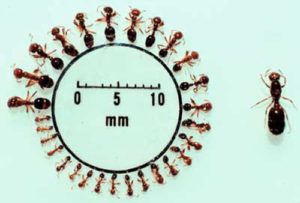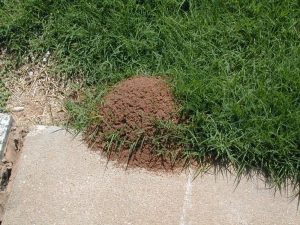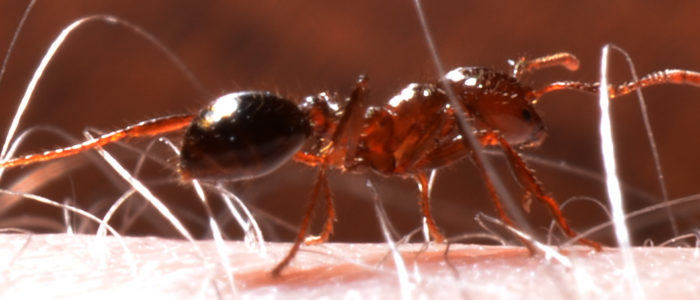In the Southeast, fire ants seem to be everywhere! They become more active during the warmer months and will start their food foraging missions in the spring, continuing into the early fall.
Brief History of the Red Imported Fire Ant
The Red Imported Fire Ant (RIFA) was brought to the US accidentally in the 1930s through the port of Mobile, Alabama. They’re originally from central South America where they have natural predators which help keep their numbers in check. These ants have no natural predators in the US, so they have spread pretty quickly. There have been attempts to introduce the natural predators from South America, but no real progress has been made on that front.
Anatomy and Biology
The body of a RIFA is reddish-brown, oval and has two segments in the waist or “pedicel.” Another way to identify a RIFA is through their antennae. Their antennae are different from some other ant species because they are made up of ten segments with the last two forming a club.
This ant species ranges in size from 1/8 – 1/4 inches. The size difference indicates what kind of worker they are. Smaller ants are minor workers with the larger ant being major workers. In between those sizes is the media worker, but the majority of ant colonies are made up of minor workers. Their life expectancy changes with respect to their size as well and ranges from 30-180 days. However, RIFA queens have been found to have a life expectancy of 2-6 years!

Lastly, RIFA have a nasty stinger at the end of their gaster that can deliver a powerful sting. The venom they release is a type of alkaloid that exhibits necrotoxic (or cell killing) activity. If someone is stung by a RIFA, a burning sensation (hence the name fire ant) will occur, and a white pustule will commonly form at the site of the sting. However, another part of the venom they release into their victim’s system is a mixture of peptides and proteins that are responsible for a lot of people’s allergic reactions.
Colony Development
After a colony has developed for a year, they will send out reproductive alates to create new colonies in an event known as mating flights. An alate, in this sense, is a reproductive male or female RIFA with wings. After mating, the males will die soon after, but the females will snap off their wings and will find a place to start a colony. A few females may bunk together right after the mating flight which aids in colony growth, but eventually, only one queen will be left and the others will be killed unless it is a multiple queen colony.
New colonies will reach several thousand workers by the time it is six months old, and mature RIFA colonies can reach as many as 240,000 workers! But typically, a colony has about 80,000 members. If the nest is disturbed, the workers will come out in full force and climb vertical surfaces like grass blades and sticks. They’ll sting whatever they can get their mandibles on, too!
Since many colonies have multiple queens and are much deeper than they are high above the ground, when the colony is threatened, the queens may split up and leave the colony before any chemical applied to the top of the mound reaches them. This may allow new colonies to form a short distance away from the original mound.
Identification and Control
One way to tell fire ants apart from other ant species (without a microscope) is the way their nests are structured. Most ant species have one central entrance tunnel. The RIFA, however, has many entrance tunnels. Their nests look like fluffy mounds of dirt with no distinct entryway.

Another way you can identify a RIFA colony is through their behavior. With most other ant species, disturbing the nest will rattle the ants and they will come out to defend the nest….eventually. Some ant species may not come out at all. But red imported fire ants will immediately start swarming. They will climb vertical surfaces like grass and sticks, too. Their aggression is a hallmark behavior and should not be experimented with. Don’t intentionally disturb RIFA nests because it can be quite painful for you in the end if they get their stingers on you!
If you have an ant problem on your property, indoors or out, call a professional. A licensed pest professional will know the best way to get rid of ants. Their control methods may involve exclusion methods that will get to the root of the problem to fix your ant problems for good.

